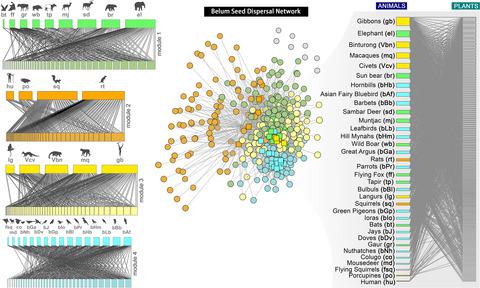Our official English website, www.x-mol.net, welcomes your feedback! (Note: you will need to create a separate account there.)
The ability to disperse large seeds, rather than body mass alone, defines the importance of animals in a hyper-diverse seed dispersal network
Journal of Ecology ( IF 5.5 ) Pub Date : 2021-11-05 , DOI: 10.1111/1365-2745.13809 Lisa Ong 1, 2 , Kim R. McConkey 2 , Ahimsa Campos‐Arceiz 1, 2
中文翻译:

传播大种子的能力,而不是单独的体重,定义了动物在超多样化种子传播网络中的重要性
更新日期:2021-11-05
Journal of Ecology ( IF 5.5 ) Pub Date : 2021-11-05 , DOI: 10.1111/1365-2745.13809 Lisa Ong 1, 2 , Kim R. McConkey 2 , Ahimsa Campos‐Arceiz 1, 2
Affiliation

|
- Large-bodied animals play irreplaceable roles in seed dispersal, partly due to their capacity to disperse large seeds. Understanding this role at a community level has been limited by the paucity of network studies that include large vertebrates, and the almost complete absence of studies including synzoochoric dispersers. Synzoochoric dispersers can disperse seeds disproportionately large for their body size, potentially overlapping the roles of large-bodied animals. A comprehensive network, inclusive of large vertebrates and synzoochorous dispersers, is imperative to understand seed dispersal at a community level.
- Here, we analysed the seed dispersal network of a hyper-diverse Sundaic forest in Malaysia using local ecological knowledge and including multiple forms of endozoochorous and synzoochorous dispersal. We evaluated the extent to which three disperser traits: body mass, seed-handling ability (size of the largest seed dispersed) and diet explained the importance of animals in the network. We evaluated dispersers' relative importance using four network metrics—degree of specialisation (nested rank), species strength, within-module connectivity (z-value) and between-modules connectivity (c-value).
- We found that seed-handling ability had the biggest effect on a disperser's importance, with strong effects on three network metrics (species strength, ecological specialisation and z-value) and moderate effects on connectivity between modules. Body mass was important in defining interactions within modules, and dietary differences defined the ecological specialisation of species in seed dispersal.
- Important dispersers in our network were large-seed dispersers (e.g. rats, gibbons), large-bodied animals, in particular the Asian elephant, and animals with frugivorous diets such as hornbills.
- Synthesis. Our work uncovers the significance of seed-handling ability in identifying pivotal seed dispersal roles in tropical rainforests. Key dispersers include large-bodied herbivores and medium-sized frugivores that could disperse large seeds by endozoochory, and smaller rodents that dispersed similar-sized seeds by synzoochory. Many of the species that emerged as particularly important for the seed dispersal network are currently threatened (e.g. the Asian elephant, gibbons and hornbills). Their protection or reintroduction should be a top conservation priority.
中文翻译:

传播大种子的能力,而不是单独的体重,定义了动物在超多样化种子传播网络中的重要性
- 大型动物在种子传播中发挥着不可替代的作用,部分原因在于它们传播大种子的能力。由于缺乏包括大型脊椎动物在内的网络研究,以及几乎完全缺乏包括同步动物分散器在内的研究,在社区层面理解这一作用受到限制。Synzoochoric 分散器可以分散与其体型不成比例的种子,可能与大型动物的角色重叠。一个全面的网络,包括大型脊椎动物和同步传播者,对于了解社区层面的种子传播是必不可少的。
- 在这里,我们利用当地生态知识分析了马来西亚一个超级多样化的圣代森林的种子传播网络,包括多种形式的内生和同步传播。我们评估了三种分散特性:体重、种子处理能力(最大种子分散的大小)和饮食在多大程度上解释了动物在网络中的重要性。我们使用四个网络指标评估分散者的相对重要性——专业化程度(嵌套等级)、物种强度、模块内连接性(z值)和模块间连接性(c值)。
- 我们发现种子处理能力对分散器的重要性影响最大,对三个网络指标(物种强度、生态专业化和z值)影响很大,对模块之间的连通性影响适中。体重对于定义模块内的相互作用很重要,而饮食差异定义了物种在种子传播中的生态专业化。
- 我们网络中的重要传播者是大型种子传播者(例如大鼠、长臂猿)、体型大的动物,特别是亚洲象,以及犀鸟等食果性食物的动物。
- 合成。我们的工作揭示了种子处理能力在确定热带雨林中关键种子传播作用方面的重要性。主要的分散器包括大型食草动物和中型果食动物,它们可以通过内生动物分散大种子,以及较小的啮齿动物,它们可以通过合生动物分散类似大小的种子。许多对种子传播网络特别重要的物种目前正受到威胁(例如亚洲象、长臂猿和犀鸟)。它们的保护或重新引入应该是保护的首要任务。


























 京公网安备 11010802027423号
京公网安备 11010802027423号